
In a world increasingly defined by the pursuit of minimalism and decluttering, the art of crafting serene and functional living spaces within the confines of small homes has become an intriguing challenge for design enthusiasts and homeowners alike. Minimalist design, with its emphasis on clean lines, uncluttered spaces, and a muted color palette, offers a compelling solution for those seeking to maximize the potential of their compact abodes.
Embracing the Beauty of Simplicity
At the heart of the minimalist approach lies the principle of simplicity. By paring down the essential elements and focusing on the fundamentals of form and function, designers can create a sense of tranquility and elegance that transcends the physical limitations of a small space. The key is to carefully curate every item, ensuring that each piece serves a purpose and contributes to the overall harmony of the room.
One of the hallmarks of minimalist design is the use of clean lines and geometric shapes in furniture and architectural features. Sleek, multifunctional pieces that seamlessly blend form and function are the cornerstones of this aesthetic, allowing homeowners to maximize the available space without sacrificing style. From modular sofas to hidden storage solutions, the minimalist approach prioritizes efficiency and a clutter-free environment.
Equally important is the color palette employed in a minimalist space. Embracing a muted and neutral color scheme, such as whites, grays, and earthy tones, creates a soothing and calming ambiance. This foundation allows for occasional pops of vibrant or contrasting hues to be introduced through accents, textiles, and artwork, adding depth and visual interest without overwhelming the overall tranquility of the space.
Integrating Nature’s Embrace
One of the most captivating aspects of minimalist design is its ability to seamlessly integrate natural elements into the living environment. By bringing the beauty of the outdoors indoors, designers can create a sense of harmony and rejuvenation that is particularly well-suited for small homes.
Lush greenery, in the form of houseplants and trailing vines, infuses a space with life and vitality, while also serving as natural air purifiers. Carefully selected botanical-inspired fabrics, wallpapers, and accessories further enhance the biophilic design, fostering a serene and grounding atmosphere.
Beyond the visual appeal, the tactile and olfactory experiences created by natural materials, such as wood, stone, and natural fibers, contribute to the overall sensory delight of a minimalist sanctuary. Plush textiles, from sumptuous blankets to indulgent throws, add an layer of cozy comfort that envelops the senses, while gentle ambient lighting casts a soothing glow, beckoning occupants to relax and rejuvenate.
Personalized Sanctuaries
While the principles of minimalism emphasize simplicity and restraint, the true beauty of this design approach lies in its ability to be personalized to reflect the unique personality and lifestyle of the homeowner. By carefully curating a gallery of artwork, cherished family heirlooms, and meaningful mementos, designers can infuse a minimalist space with character and individuality.
The team at Urban Grace Interiors understands that each client’s vision is as distinct as their personal journey. Through a collaborative process, they work closely with homeowners to identify their passions, hobbies, and personal style, seamlessly integrating these elements into a cohesive minimalist design that celebrates the occupants’ unique identity and story.
Elevating Everyday Living
Embracing minimalist design in small homes is not merely about creating a visually appealing space; it’s about elevating the everyday experience and fostering a sense of calm and well-being within the confines of limited square footage. By carefully curating every element, designers can craft sanctuaries that soothe the senses and nourish the soul, offering respite from the demands of modern life.
Whether it’s the tranquil embrace of a minimalist living room, the rejuvenating energy of a nature-inspired bedroom, or the harmonious flow of a multifunctional kitchen, the power of minimalist design lies in its ability to transform small spaces into oases of serenity and functionality.
Maximizing Potential in Compact Abodes
For homeowners facing the challenges of limited square footage, the minimalist approach offers a versatile and practical solution that optimizes the available space without compromising on style or comfort. By embracing multifunctional furniture, streamlined storage solutions, and strategic lighting, designers can create the illusion of space and foster a sense of openness that belies the physical constraints of the home.
Moreover, the simplicity and clean aesthetic of minimalist design lend themselves well to accommodating the ever-evolving needs of modern living. Flexible layouts, adaptable furnishings, and technologically-integrated features allow small-space dwellers to seamlessly adapt their environments to changing lifestyles, work-from-home demands, and family dynamics.
Elevating Small-Space Living
In the pursuit of creating serene sanctuaries within the confines of small homes, the minimalist design approach offers a compelling and transformative solution. By embracing the beauty of simplicity, integrating nature’s embrace, and infusing personal touches, designers can craft oases of tranquility that nourish the senses and elevate the everyday experience.
Whether it’s a cozy urban apartment, a compact family home, or a petite loft, the principles of minimalist design empower homeowners to maximize the potential of their living spaces, fostering a sense of calm, comfort, and functionality** that transcends the physical limitations of square footage.
So, as you embark on your journey to create your own minimalist marvel, remember that the key lies in curating with intention, embracing the power of simplicity, and infusing your personal touch to craft a sanctuary that resonates with your unique style and well-being.

